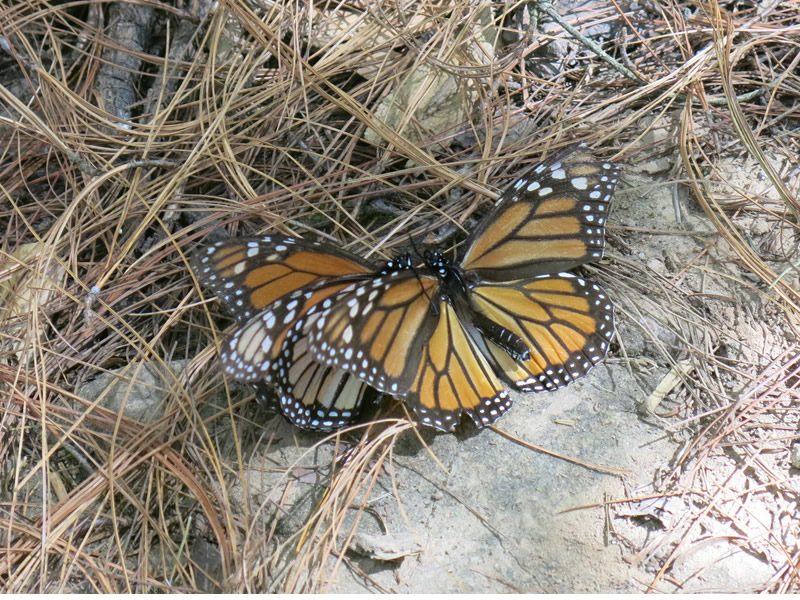Reports of Monarch butterfly sightings in South Texas are hitting email lists, the web and social media this week, as the hearty orange-and-black butterflies begin their massive departure from Michoacán, Mexico, making their multi-generational journey north.

Get a room! Monarch butterflies drop to the ground in a mating frenzy upon departing their roosts in Michoacán. Photo by Estela Romero via Journey North
“The massive leaving is occurring right now!” wrote Journey North correspondent Estela Romero from Morelia, Mexico, on March 13, as millions of butterflies fled their roosts. “Monarchs are clouding our town, flying by the towers of our downtown churches in a majestic performance as if dancing to music!” Romero provides regular dispatches from the ancestral roosting sites to the educational organization that tracks the Monarch and other migrations. Read Romero’s updates here.
The butterflies leave Mexico each year right around the Equinox, which occurred at precisely at 11:57 AM CDT in San Antonio on Thursday. The butterflies get their cues from the sun, rouse themselves from a semi-hibernative state, and mate. Then they start heading north, following the blooming flowers that provide fuel in the form of nectar in search milkweed–the only plant on which they will lay their eggs and be able to continue their life cycle. The “Texas Funnel”–South Texas and the Hill Country– is often the first stop for egg-laying, and thus begets the first generation of new migrating Monarchs.
I spotted my FOS (First of Season) Monarch on Friday, March 20, about 6:30 PM, along the San Antonio River Walk right near downtown. Alex Rivard reported a Monarch in the Dignowity Hill neighborhood of the Alamo City the same day. The faded beauty observed on my evening walk was nectaring on purple Mountain Laurel flowers, the early spring trees that offer a distinct grape Kool-aid scented bloom. As I approached the butterfly, she lighted upstream.
Harlen Aschen, a regular butterfly watcher based in Port Lavaca, Texas, shared his FOS Monarch spotting March 19 with the DPLEX-list, an old school style list serv that reaches hundreds of butterfly buffs.
Late this afternoon a monarch flew from the SSW out across the open pasture and finally picked a mesquite just north of the cabin to land in and spend the night. It wasn’t new but not close enough to tell sex. We will all be out for a few more days to see if any others follow and if we can get any to pose for a photo. This would put this one about 640 miles north of the sanctuaries … 65 miles ESE of San Antonio. A light north breeze today and in mid-70’s. –Harlen
Last year, my FOS arrived on March 17. That was a different year, with ample, well-timed rains and an abundance of milkweed waiting. This year our spring follows a brutally dry winter and extremely cold temperatures–including three hard freezes–that have resulted in a delayed start to spring.

Front yard milkweed 2013: Look how big the milkweed was in my yard on March 17 compared to the same plant, a year later, below. This butterfly laid 12 eggs here that day. Photo by Monika Maeckle
The Tropical milkweed, Asclepias curassavica, in my yard is barely out of the ground, and the Swamp milkweed Asclepias incarnata, on the Llano River is not even showing. Antelope Horns, Asclepias asperula? Haven’t see any at our place, but others report a bounty.
As noted in a previous post, cold winters are actually good for the migration, since not only do colder temps kill fireants and other predators, but they slow down the butterflies and prevent them from getting ahead of the plants. Check out the difference between last year (above) and this year’s milkweed foliage (below).
One common thread carried over from 2013: again, this year looks to be the worst in history, population wise for Monarchs. Last year we bemoaned the paltry 2.93 acres of Oyamel forest occupied by the Monarchs in Mexico. But 2014 knocked out that dreary record, with only 1.65 acres–about 72,000 square feet–of forest occupied by Monarch butterflies. Scientists measure the number of acres occupied by the butterflies each year at their ancestral roosts to estimate how many butterflies exist.
That said, we must marvel at the tenacity and endurance of these small, slight creatures. Those spotted this week have just traveled 850 miles in search of milkweed so they can lay eggs and continue the life cycle. They just don’t give up.
And we won’t either.
More stories like this:
- As Monarch butterfly Numbers Plummet, will Migration Become Extinct?
- Austin Butterfly Forum to Feature Historic Gathering of Monarch Butterfly Flutterati
- Founder of the Monarch Roosting Spot Lives a Quiet Life in Austin, Texas
- Sign the Petition to get Milkweed Planted at the White House
- NAFTA Leaders, Monsanto: Let’s Save the Monarch Butterfly Migration
- Will Obama talk Monarch Butterfly Migration with Leaders of Mexico and Canada?
- What does climate change mean for Monarch butterflies?
- Monarch butterflies: the Panda Bears of Climate Change?
- Persnickety Texas Native Milkweeds Pose Challenges for Growers
- Texas Butterfly Ranch Native Texas Milkweed Guide
Like what you’re reading? Follow butterfly and native plant news at the Texas Butterfly Ranch. Sign up for email delivery, like us on Facebook, or follow us on Twitter, @monikam.



Saw my first Monarch yesterday in my backyard in Hollywood Park. Also noticed that the milkweed planted last year is returning to my garden, front and back. I did plant 3 good size tropical milkweeds from the SA Botanical Garden too. So hopefully I will contribute to the food and nectering of the Monarchs migrating this year and the resident Monarchs. now we just need some rain so I won’t have to water so much!
We saw our first monarchs today. Two were searching flowers near our mailbox near Webberville, 15 miles east of Austin.
Would you know of any good educational information on planting milkweed and providing a welcoming garden for the Monarchs in Spanish ? My mom is in south Texas ( Laredo) and is an avid gardener but not the best with the computer. She would also like to spread the word and encourage our family and all her gardening friends to create butterfly gardens for the Monarchs. I sent her milkweed seeds for Mothers Day but any additional resources would be welcomed. Thank you in advance !
HI ivette,
I don’t know of anything offhand, but you can Google “jar dines para mariposa monarca” and quite a few options come up. HEre’s a link:http://www.mariposapedia.com/creando-jardin-mariposas/ Of course, you have to speak/read Spanish for it to be useful. Good luck. Please check in and let us know how it goes.
I would like to follow the Monarch migration and also where to get milk weed seeds or plants here in San Antonio.
[…] https://texasbutterflyranch.com/2014/03/23/right-on-time-first-of-season-monarchs-arrive-in-san-anton… […]